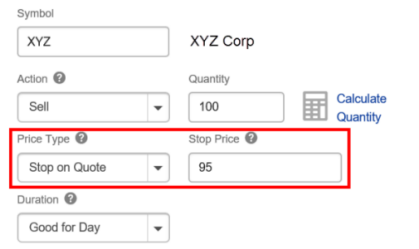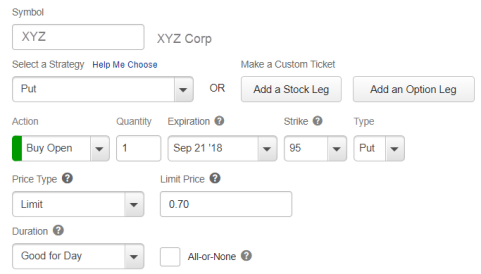Potentially protect a stock position against a market drop
E*TRADE from Morgan Stanley
02/28/19If you’ve been investing in the stock market for a while, you probably understand that stocks don’t consistently move higher and in a straight line. Some years, the broader stock market may experience setbacks of 5% to 10%. Other years, the broader market can potentially decline by as much as 40% or 50%. And sometimes, declines in individual stocks may be even greater.
But there are ways to potentially protect against large declines. In this article, you’ll learn two ways that might limit losses in your investments.
Just say "stop"
One way of possibly limiting losses in a stock is by using a stop order.
When you place a sell stop order, you’re instructing your broker to automatically enter an order to sell your stock if it drops to the stop price you indicated. A sell stop order automatically becomes a market order when the stock drops to the customer’s stop price.
Here’s how it works:
Suppose you buy 100 shares of XYZ at $100. This represents a $10,000 investment and you’d prefer to limit your losses to no more than 5%.
When buying XYZ, you could simultaneously place a stop order at $95.
By following these steps, you’ll have placed a stop order. Great! Now what does it mean? In the above example, if XYZ drops to $95, an order would be automatically triggered to sell your stock at the market or next available traded price.
Risks of a Stop Order
While a stop order can help potentially limit losses, there are risks to consider. Let’s continue with our $95 stop order example. In calm markets, if XYZ stock trades through $95, you most likely will get the trade executed near that stop price. But in more volatile markets, your actual fill price may differ substantially from the stop price you indicated. For example, suppose XYZ reports earnings after the close and the next day, the stock opens at $80. Since the stock price went below $95, your stop order would trigger and execute at $80, which is a much bigger loss than you had planned on when setting the stop price.
Protecting with a put option
One way to avoid the risk of getting stopped out (in other words, when the stop order executes) from your stock for a bigger-than-expected loss is by buying a put option. Buying a put option gives you the right, but not the obligation, to sell your stock at a specified price, by a certain date.
When you buy a put option, by paying a small sum up front, called the premium, you’re able to wait and see in which direction a stock moves before deciding whether to buy it or sell it.
So continuing with the example of XYZ stock, suppose you’d still like to limit your losses to around 5% of the current stock price, rather than placing a stop order at $95, you can buy a 95-strike put option. Buying the 95-strike put, you’d have the right, but not the obligation to sell your XYZ stock at $95 per share.
Let’s suppose that you can buy a 95-strike put that expires in 60 days for $0.70. Then, by paying 70 cents (or $70 per contract), you’d have 60 days in which you’d be able to wait and see how XYZ stock performed prior to selling it.
When you buy a put option, by paying a small sum up front, called the premium, you’re able to wait and see in which direction a stock moves before deciding whether to buy it or sell it.
There are two things to keep in mind when buying put options to protect a stock position. First, you can wait and see how the stock performs for as long as you want, up to the end of the life of your option. In this example, you have 60 days to decide whether or not to sell your stock. Second, even if the stock drops below $95 per share, you may not want to sell it right away. You can wait to see if the stock rebounds. That’s something you can’t do with stop orders.
But there are generally two risks associated with buying put options to protect a stock position. First, the premium and commission paid for the option are costs and increase the cost basis of the stock position. Second, it’s possible for the option to expire worthless. So, if the stock remains above $95, you would lose the entire premium of the option. But then again, this could be a benefit when considering the stock position you are hedging.

